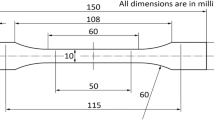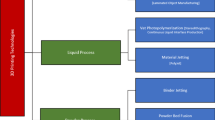Abstract
Specialty thermoplastic materials based on fluoropolymer polyvinylidene fluoride (PVDF) became commercially available to the 3D printing community only recently. Additive manufacturing of PVDF-based structural components suited for harsher operational conditions is important for more demanding industrial sectors such as biomedical/chemical, aerospace, or automotive. Such components must ensure adequate mechanical performance in diverse deformation cases. Hence, this paper reports on fused filament fabrication (FFF) and quasi-static tensile, flexural and compressive testing of PVDF homopolymer, biocompatible PVDF-co-hexafluoropropylene (PVDF-HFP) copolymer, and static-dissipative PVDF-HFP/graphene composite specimens, which were printed with triangular lattice infill of variable density for addressing the influence of lightweighting. Printability in an open-chamber-based FFF machine is discussed in terms of part warpage and adhesion issues, which aggravate FFF process because of the higher degree of crystallinity, larger coefficient of thermal expansion, and hydrophobicity of PVDF. It was found that these printing complications are alleviated by applying lower printing speed and temperature together with the use of wider brims and a specialized FFF-tailored adhesive. The measured stress–strain curves are examined to analyze changes in strengths and moduli of elasticity of the specimens as a function of infill density including comparisons in ductility, failure mode, and anisotropic mechanical behavior such as tension–compression asymmetry. The presented results serve as a guideline for additive manufacturing of functional PVDF-based load-bearing components that are intended for service in different loading regimes.













Similar content being viewed by others
References
Niaki MK, Torabi SA, Nonino F (2019) Why manufacturers adopt additive manufacturing technologies: the role of sustainability. J Clean Prod 222:381–392. https://doi.org/10.1016/j.jclepro.2019.03.019
Ngo TD, Kashani A, Imbalzano G, Nguyen KTQ, Hui D (2018) Additive manufacturing (3D printing): a review of materials, methods, applications and challenges. Compos Part B Eng 143:172–196. https://doi.org/10.1016/j.compositesb.2018.02.012
Singh S, Singh G, Prakash C, Ramakrishna S (2020) Current status and future directions of fused filament fabrication. J Manuf Process 55:288–306. https://doi.org/10.1016/j.jmapro.2020.04.049
Suárez L, Domínguez M (2020) Sustainability and environmental impact of fused deposition modelling (FDM) technologies. Int J Adv Manuf Technol 106:1267–1279. https://doi.org/10.1007/s00170-019-04676-0
Gordelier TJ, Thies PR, Turner L, Johanning L (2019) Optimising the FDM additive manufacturing process to achieve maximum tensile strength: a state-of-the-art review. Rapid Prototyp J 25:953–971. https://doi.org/10.1108/RPJ-07-2018-0183
Dizon JRC, Espera AH, Chen Q, Advincula RC (2018) Mechanical characterization of 3D-printed polymers. Addit Manuf 20:44–67. https://doi.org/10.1016/j.addma.2017.12.002
Wu H, Fahy WP, Kim S, Kim H, Zhao N, Pilato L, Kafi A, Bateman S, Koo JH (2020) Recent developments in polymers/polymer nanocomposites for additive manufacturing. Prog Mater Sci 111:100638. https://doi.org/10.1016/j.pmatsci.2020.100638
Ameduri B, Sawada H (2016) Fluorinated polymers, Royal Society of Chemistry, Cambridge, https://doi.org/10.1039/9781782629368
Cardoso VF, Correia DM, Ribeiro C, Fernandes MM, Lanceros-Méndez S (2018) Fluorinated polymers as smart materials for advanced biomedical applications. Polymers (Basel) 10:1–26. https://doi.org/10.3390/polym10020161
Améduri B (2020) The promising future of fluoropolymers. Macromol Chem Phys 221:1–14. https://doi.org/10.1002/macp.201900573
Ameduri B (2009) From vinylidene fluoride (VDF) to the applications of VDF-containing polymers and copolymers: recent developments and future trends. Chem Rev 109:6632–6686. https://doi.org/10.1021/cr800187m
Drobny J (2015) Properties of polyvinylidene fluoride. In: Spec. Thermoplast. Springer Berlin Heidelberg, Berlin, pp 26–31. https://doi.org/10.1007/978-3-662-46419-9_7
Mishra S, Unnikrishnan L, Nayak SK, Mohanty S (2019) Advances in piezoelectric polymer composites for energy harvesting applications: a systematic review. Macromol Mater Eng 304:1–25. https://doi.org/10.1002/mame.201800463
Teng H (2012) Overview of the development of the fluoropolymer industry. Appl Sci 2:496–512. https://doi.org/10.3390/app2020496
Momenzadeh N, Miyanaji H, Berfield TA (2019) Influences of zirconium tungstate additives on characteristics of polyvinylidene fluoride (PVDF) components fabricated via material extrusion additive manufacturing process. Int J Adv Manuf Technol 103:4713–4720. https://doi.org/10.1007/s00170-019-03978-7
Porter DA, Hoang TVT, Berfield TA (2017) Effects of in-situ poling and process parameters on fused filament fabrication printed PVDF sheet mechanical and electrical properties. Addit Manuf 13:81–92. https://doi.org/10.1016/j.addma.2016.11.005
Petersmann S, Spoerk M, Van De Steene W, Üçal M, Wiener J, Pinter G, Arbeiter F (2020) Mechanical properties of polymeric implant materials produced by extrusion-based additive manufacturing. J Mech Behav Biomed Mater 104:103611. https://doi.org/10.1016/j.jmbbm.2019.103611
Momenzadeh N, Miyanaji H, Porter DA, Berfield TA (2020) Polyvinylidene fluoride (PVDF) as a feedstock for material extrusion additive manufacturing. Rapid Prototyp J 26:156–163. https://doi.org/10.1108/RPJ-08-2018-0203
Dong G, Kang Y, Cao M (2014) Application and modification of poly(vinylidene fluoride) (PVDF) membranes - a review. J Membr Sci 463:145–165. https://doi.org/10.1016/j.memsci.2014.03.055
Ning C, Zhou Z, Tan G, Zhu Y, Mao C (2018) Electroactive polymers for tissue regeneration: developments and perspectives. Prog Polym Sci 81:144–162. https://doi.org/10.1016/j.progpolymsci.2018.01.001
Ribeiro C, Costa CM, Correia DM, Nunes-Pereira J, Oliveira J, Martins P, Gonçalves R, Cardoso VF, Lanceros-Méndez S (2018) Electroactive poly(vinylidene fluoride)-based structures for advanced applications. Nat Protoc 13:681–704. https://doi.org/10.1038/nprot.2017.157
Chen C, Wang X, Wang Y, Yang D, Yao F, Zhang W, Wang B, Sewvandi GA, Yang D, Hu D (2020) Additive manufacturing of piezoelectric materials. Adv Funct Mater 30:2005141. https://doi.org/10.1002/adfm.202005141
Goh GD, Yap YL, Tan HKJ, Sing SL, Goh GL, Yeong WY (2020) Process–structure–properties in polymer additive manufacturing via material extrusion: a review. Crit Rev Solid State Mater Sci 45:113–133. https://doi.org/10.1080/10408436.2018.1549977
Dudescu C, Racz L (2018) Effects of raster orientation, infill rate and infill pattern on the mechanical properties of 3D printed materials. ACTA Univ Cibiniensis 69:23–30. https://doi.org/10.1515/aucts-2017-0004
Gonabadi H, Yadav A, Bull SJ (2020) The effect of processing parameters on the mechanical characteristics of PLA produced by a 3D FFF printer. Int J Adv Manuf Technol 111:695–709. https://doi.org/10.1007/s00170-020-06138-4
Terekhina S, Skornyakov I, Tarasova T, Egorov S (2019) Effects of the infill density on the mechanical properties of nylon specimens made by filament fused fabrication. Technologies. 7:57. https://doi.org/10.3390/technologies7030057
Nadernezhad A, Unal S, Khani N, Koc B (2019) Material extrusion-based additive manufacturing of structurally controlled poly(lactic acid)/carbon nanotube nanocomposites. Int J Adv Manuf Technol 102:2119–2132. https://doi.org/10.1007/s00170-018-03283-9
Carneiro OS, Silva AF, Gomes R (2015) Fused deposition modeling with polypropylene. Mater Des 83:768–776. https://doi.org/10.1016/j.matdes.2015.06.053
Torres J, Cotelo J, Karl J, Gordon AP (2015) Mechanical property optimization of FDM PLA in shear with multiple objectives. Jom. 67:1183–1193. https://doi.org/10.1007/s11837-015-1367-y
Zhou X, Hsieh SJ, Ting CC (2018) Modelling and estimation of tensile behaviour of polylactic acid parts manufactured by fused deposition modelling using finite element analysis and knowledge-based library. Virtual Phys Prototyp 13:177–190. https://doi.org/10.1080/17452759.2018.1442681
Cerda-Avila SN, Medellín-Castillo HI, Lim T (2020) An experimental methodology to analyse the structural behaviour of FDM parts with variable process parameters. Rapid Prototyp J 26:1615–1625. https://doi.org/10.1108/RPJ-12-2019-0312
Mahmood S, Qureshi AJ, Goh KL, Talamona D (2017) Tensile strength of partially filled FFF printed parts: experimental results. Rapid Prototyp J 23:122–128. https://doi.org/10.1108/RPJ-08-2015-0115
Rinaldi M, Ghidini T, Cecchini F, Brandao A, Nanni F (2018) Additive layer manufacturing of poly (ether ether ketone) via FDM. Compos Part B Eng 145:162–172. https://doi.org/10.1016/j.compositesb.2018.03.029
Vaezi M, Yang S (2015) Extrusion-based additive manufacturing of PEEK for biomedical applications. Virtual Phys Prototyp 10:123–135. https://doi.org/10.1080/17452759.2015.1097053
Baich L, Manogharan G, Marie H (2015) Study of infill print design on production cost-time of 3D printed ABS parts. Int J Rapid Manuf 5:308. https://doi.org/10.1504/ijrapidm.2015.074809
Alvarez KLC, Lagos RFC, Aizpun M (2016) Investigating the influence of infill percentage on the mechanical properties of fused deposition modelled ABS parts. Ing e Investig 36:110–116. https://doi.org/10.15446/ing.investig.v36n3.56610
Kynar & Kynar Flex (n.d.). polyvinylidene fluoride performance characteristics & data, Arkema Inc., 2014, 20 p.
Spoerk M, Holzer C, Gonzalez-Gutierrez J (2020) Material extrusion-based additive manufacturing of polypropylene: a review on how to improve dimensional inaccuracy and warpage. J Appl Polym Sci 137:1–16. https://doi.org/10.1002/app.48545
Bashford D, (1997) Thermoplastics directory and databook
Dey A, Yodo N (2019) A systematic survey of FDM process parameter optimization and their influence on part characteristics. J Manuf Mater Process 3:64. https://doi.org/10.3390/jmmp3030064
Ariza Gomez AJ, Contreras MM, Vaz MA, Costa CA, Costa MF (2020) Temperature-time large strain mechanical model for poly(vinylidene fluoride). Polym Test 82:106312. https://doi.org/10.1016/j.polymertesting.2019.106312
Challier M, Besson J, Laiarinandrasana L, Piques R (2006) Damage and fracture of polyvinylidene fluoride (PVDF) at 20 °C: experiments and modelling. Eng Fract Mech 73:79–90. https://doi.org/10.1016/j.engfracmech.2005.06.007
Laiarinandrasana L, Besson J, Lafarge M, Hochstetter G (2009) Temperature dependent mechanical behaviour of PVDF: experiments and numerical modelling. Int J Plast 25:1301–1324. https://doi.org/10.1016/j.ijplas.2008.09.008
Reis JML, Motta EP, Da Costa Mattos HS (2015) Elasto-viscoplastic behaviour of a polyvinylidene fluoride (PVDF) in tension. Polym Test 46:9–13. https://doi.org/10.1016/j.polymertesting.2015.06.013
Fleck NA, Deshpande VS, Ashby MF (2010) Micro-architectured materials: past, present and future. Proc R Soc A Math Phys Eng Sci 466:2495–2516. https://doi.org/10.1098/rspa.2010.0215
Jiang Y, Raney JR (2019) 3D printing of amylopectin-based natural fiber composites. Adv Mater Technol 4:1900521. https://doi.org/10.1002/admt.201900521
Bakır AA, Atik R, Özerinç S (2021) Effect of fused deposition modeling process parameters on the mechanical properties of recycled polyethylene terephthalate parts. J Appl Polym Sci 138:49709. https://doi.org/10.1002/app.49709
Costa P, Nunes-Pereira J, Oliveira J, Silva J, Moreira JA, Carabineiro SAC, Buijnsters JG, Lanceros-Mendez S (2017) High-performance graphene-based carbon nanofiller/polymer composites for piezoresistive sensor applications. Compos Sci Technol 153:241–252. https://doi.org/10.1016/j.compscitech.2017.11.001
Pazat A, Barrès C, Bruno F, Janin C, Beyou E (2018) Preparation and properties of elastomer composites containing “graphene”-based fillers: a review. Polym Rev 58:403–443. https://doi.org/10.1080/15583724.2017.1403446
Fontananova E, Bahattab MA, Aljlil SA, Alowairdy M, Rinaldi G, Vuono D, Nagy JB, Drioli E, Di Profio G (2015) From hydrophobic to hydrophilic polyvinylidenefluoride (PVDF) membranes by gaining new insight into material’s properties. RSC Adv 5:56219–56231. https://doi.org/10.1039/c5ra08388e
Sieradzka M, Fryczkowski R, Biniaś D, Biniaś W, Janicki J (2020) A facile approach to obtaining PVDF/graphene fibers and the effect of nanoadditive on the structure and properties of nanocomposites. Polym Test 81:106229. https://doi.org/10.1016/j.polymertesting.2019.106229
Aw YY, Yeoh CK, Idris MA, Teh PL, Hamzah KA, Sazali SA (2018) Effect of printing parameters on tensile, dynamic mechanical, and thermoelectric properties of FDM 3D printed CABS/ZnO composites. Materials (Basel) 11:466. https://doi.org/10.3390/ma11040466
Donato GHB, Bianchi M (2012) Pressure dependent yield criteria applied for improving design practices and integrity assessments against yielding of engineering polymers. J Mater Res Technol 1:2–7. https://doi.org/10.1016/S2238-7854(12)70002-9
Acknowledgements
This research was funded by a grant No. S-MIP-17-89 from the Research Council of Lithuania (project acronym: FLEXYMECH-3DP).
Availability of data and material
The data required to reproduce these findings cannot be shared at this time as the data also forms part of an ongoing study.
Code Availability
There are no software codes to share.
Funding
The research leading to these results received funding from the Research Council of Lithuania under Grant Agreement No. S-MIP-17-89.
Author information
Authors and Affiliations
Contributions
Farusil Najeeb Mullaveettil: investigation, formal analysis, data curation, visualization, and writing — original draft
Rolanas Dauksevicius: conceptualization, supervision, funding acquisition, formal analysis, visualization, and writing — review and editing
Marius Rimasauskas: methodology, resources, investigation, formal analysis, and writing — review and editing
Valdas Grigaliunas: investigation, resources, writing — review and editing
Corresponding author
Ethics declarations
Conflict of interest
The authors declare no competing interests.
Additional information
Publisher’s note
Springer Nature remains neutral with regard to jurisdictional claims in published maps and institutional affiliations.
Rights and permissions
About this article
Cite this article
Mullaveettil, F.N., Dauksevicius, R., Rimasauskas, M. et al. Fused filament fabrication and mechanical performance of PVDF-based specialty thermoplastics. Int J Adv Manuf Technol 117, 3267–3280 (2021). https://doi.org/10.1007/s00170-021-07887-6
Received:
Accepted:
Published:
Issue Date:
DOI: https://doi.org/10.1007/s00170-021-07887-6




